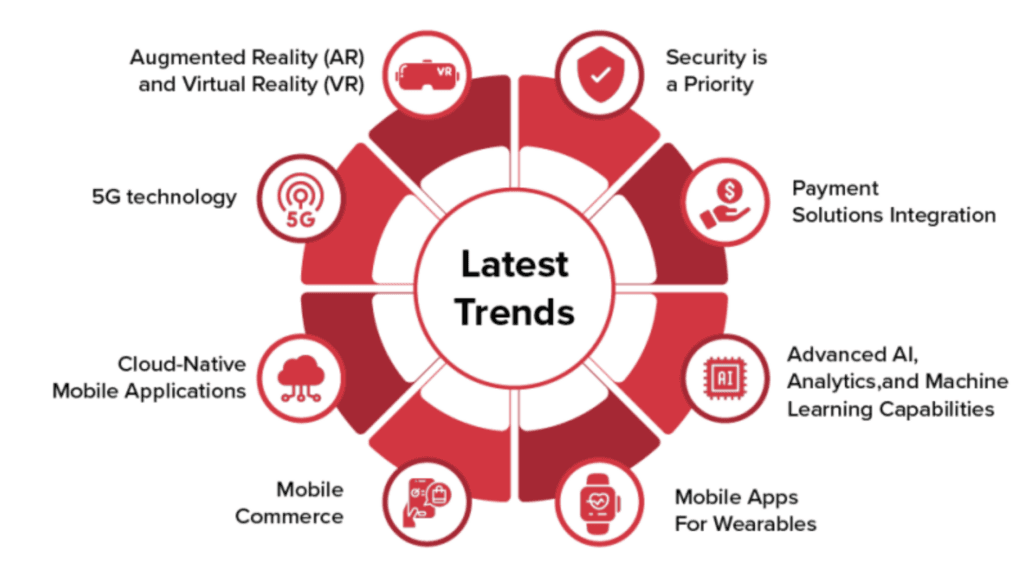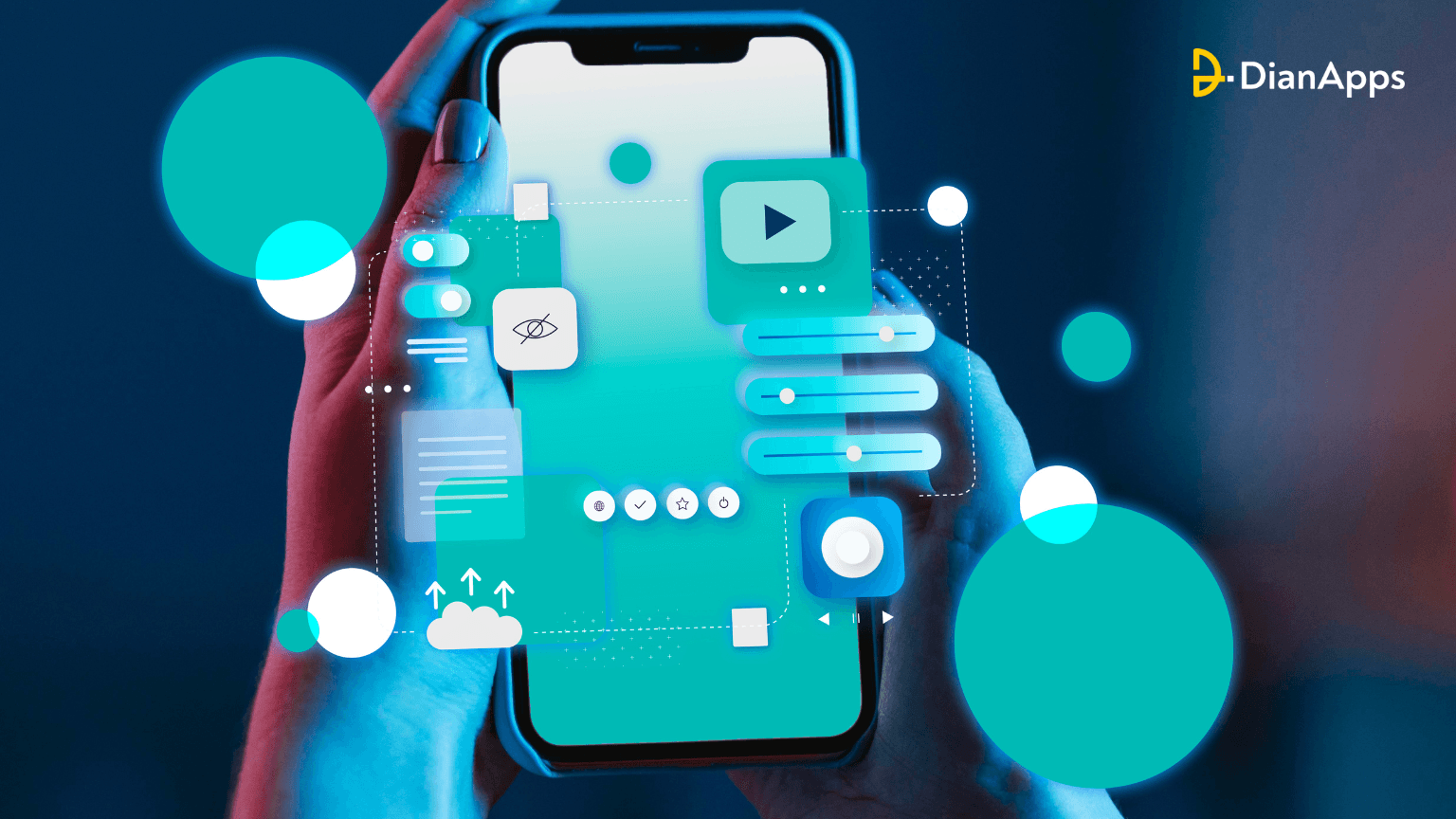Are you an iOS user who gets excited with the latest updates that take place now and then?
If so, then there is good news for you!
Since, the field of iOS app development services undergoes continual transformation, marked by annual introductions of new trends and technologies. As we head towards the upcoming year – 2024, keeping an eye on the latest iOS App Development Trends is crucial for creating successful and impactful applications.
Global mobile app market statistics for 2023 reveal a staggering $240 billion valuation, growing at a CAGR of 13.4%. With a substantial market share, leading iOS app developers are encouraged to keep themselves ahead of the curve, engaging in highly innovative development projects.
Therefore, this blog uncovers the mainstream iOS app development trends anticipated to dominate in 2024, providing developers with insights essential for crafting compelling and inventive mobile applications.

Latest iOS App Development Trends in 2024
1. Digital app security
iOS app developers are focusing on making your data super secure and private. They’re using things like encrypted user data and multi-factor authentication to add extra layers of protection. This is because data breaches can be really expensive, costing over $5 million in 2023.
To keep your info safe, they’re using techniques like encryption, hashing, and obfuscation. Apple’s AppTransport Security (ATS) is like an extra shield, making sure that when the app integrates with website development services, your data stays safe. All these efforts show how much they care about keeping your information secure and earning your trust.
2. Mobile commerce
A trend from iOS Development in 2023 – Mobile Commerce (m-commerce) is still a standout trend in the latest mobile apps, especially for e-commerce. Many online stores operate through mobile apps, offering exciting opportunities in 2024. Approximately 25% of eCommerce sales come from mobile apps, and this number is expected to grow as the mobile sector continues to expand.
Both business-to-business (B2B) and business-to-consumer (B2C) sectors are heavily relying on mobile commerce apps, including iOS Development services, to boost revenue. Keeping up with these trends is crucial for businesses aiming to thrive in the field of mCommerce, where the use of mobile apps, particularly on iOS, is becoming increasingly central for successful transactions.
3. P2P mobile apps
Peer-to-peer (P2P) mobile apps enable direct connections between users, becoming increasingly popular due to the surge in online transactions. Internationally, people are shifting from traditional payment methods to mobile apps like Google Pay and Venmo for enhanced security and convenience. The trend extends to various tailored P2P apps for ride-sharing, music-sharing, file-sharing, etc., contributing to the app industry’s growth.
In the future, such apps will help businesses cut costs and boost return on investment (ROI), reflecting the ongoing shift towards secure and efficient transaction methods.
4. Swift 6
One of the standout approaches for crafting iOS apps is utilizing Swift, known as one of the best methods for its simplicity and ease of learning. This language is favored by a vast community of coders globally, with tech giants like Slack, LinkedIn, Apple, and SkyGuide employing Swift 6 for iPhone app development.
Swift’s appeal extends to its clear syntax, enhancing readability and comprehension. It seamlessly integrates multiple APIs, ensuring compatibility and module stability. This feature allows iOS developers to concentrate on delivering high-quality code and focusing on the underlying logic.
In essence, these trends in iOS development have the potential to elevate Swift’s popularity even further. As technology evolves rapidly, we can anticipate witnessing more innovative developments in the future.
Don’t forget to read about the process of creating your blog app with SwiftUI!
5. Cloud Computing
As the popularity of this technology grows, there’s an increasing trend in developing more iOS applications to leverage its capabilities. Beyond collaboration apps, there’s a notable consideration for data storage apps. iOS app development is on the rise.
The utilization of the cloud allows for the creation of iOS apps with a centralized infrastructure accessible from anywhere, on any system. This flexibility demonstrates the ability to scale the app rapidly without the concerns of expensive hardware maintenance.
Cloud computing finds effective applications by providing a secure and centralized location for streamlined company operations. iOS apps, in particular, leverage this technology for storing and backing up documents.
Cloud integration emerges as one of the latest trends in iOS development, marking a notable shift in the market.
6. Super-app
WeChat, renowned as the world’s most popular messaging app, goes beyond just messaging. Users leverage it to create social networks, play games, book taxis, process payments, pay bills, order food, and much more. This growing trend has sparked a demand for super apps—applications that consolidate diverse functionalities into a single platform. Anticipated to emerge in 2024, these super apps aim to provide users with a comprehensive and seamless experience.
Popular messaging apps like WhatsApp have already integrated features such as payments, showcasing the shift towards creating more versatile and engaging user experiences. If you’re an iOS app developer, consider incorporating such user-centric features to transform your app into a super app, offering enhanced functionality and diverse engagement opportunities.
7. Voice-integrated app
Voice-activated apps are gaining popularity, riding the wave of increased use of smart speakers and voice assistants. Apps integrated with voice features, like Alexa and Siri, are thriving, hinting at a rising trend for voice-activated iOS apps. These apps can extend beyond simple commands, encompassing functions like search, navigation, and more.
Siri, a prominent feature in iOS, empowers users to automate tasks and execute specific actions within apps using voice commands. For instance, imagine creating a Siri shortcut in a grocery delivery app to swiftly order your favorite food or kickstarting a workout session in your fitness app.
Developers can enhance user experience by incorporating Siri buttons into their apps, enabling seamless voice interactions. As the demand for hands-free control grows, Siri’s integration has the potential to significantly elevate the functionality of iOS apps.
8. Beacons & iBeacons
Beacons and iBeacons, using low-energy Bluetooth signals, transmit information to nearby devices. Leveraging beacons allows businesses to send contextual, location-based messages to consumers. Specifically designed for iOS devices, Apple’s iBeacons offer an exclusive platform for this technology.
In mobile app development, beacons and iBeacons serve as potent tools for delivering relevant notifications. Businesses can target customers in specific locations, fostering new and effective interactions. Additionally, enhancing security is a noteworthy application of beacons. App developers can use beacon technology to restrict user access to certain app areas or features, providing an added layer of protection for sensitive data.
9. Predictive analytics
In the upcoming year, businesses of all sizes are poised to increasingly embrace predictive analytics in their operations. This technology leverages data analysis to forecast future events, trends, and customer behavior. Its widespread adoption is anticipated to enhance marketing campaigns, pinpoint opportunities and risks, and facilitate more informed decisions on resource allocation.
With the growing accessibility of data and advancing computing power, predictive analytics is anticipated to evolve into a crucial tool across diverse industries. This trend signifies a shift towards data-driven decision-making and a recognition of the invaluable insights that predictive analytics can offer for achieving business objectives.
10. Data Investment
According to Statista, a whopping 180 zettabytes of data will be all around us by 2025. For app development, this data is like a crystal ball, helping us predict future trends and plan better strategies. It’s so accurate that investing in data is one of the smartest moves for iOS app development in 2024.
This trend allows us to upgrade our app plans and goals. Predictive analysis, using cool tech like Artificial Intelligence and Machine Learning, helps us strategize our business better. To stay ahead, it’s crucial to use these smart strategies and embrace the power of data in the future.
What does the Future hold for iOS?
In 2024, iOS development companies are poised for excitement with the integration of high-level technology trends such as the Internet of Things (IoT), beacons, Artificial Intelligence (AI), and Machine Learning (ML). Apple’s latest features for development teams, coupled with the advancements introduced in iOS 16 and iOS 17 versions, further contribute to the same.
Developers are required to closely monitor these updates, leveraging them to think strategically and creatively about anticipating the evolving desires and needs of end users.
Final Words-
As we approach 2024, the iOS app development industry demands constant adaptation to emerging technologies like AR/VR, AI/ML, blockchain, and cloud-based development.
For any mobile app development company, staying ahead in this rapidly evolving field is pivotal for success. Not only that but making sure that developers can fully leverage the iOS platform’s potential and deliver innovative apps that meet users’ needs.
With over 6.6 million apps available for Android and iOS, the industry is expanding rapidly. Developers must align with trends to evolve with technology, fostering better user experiences and building a more loyal user base.
If you wish to leverage the latest Android and iPhone app development trends outlined in this article, hire iOS app developers for the best-in-class implementation. Contact us now!










Leave a Comment
Your email address will not be published. Required fields are marked *